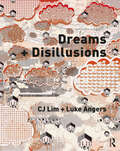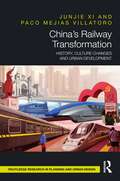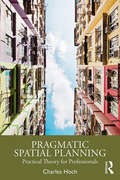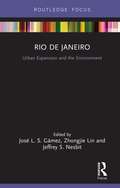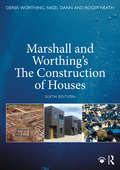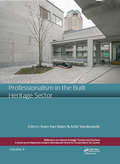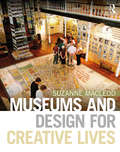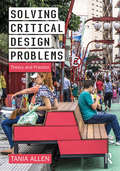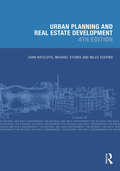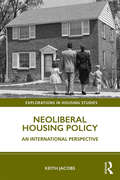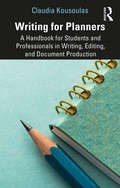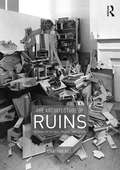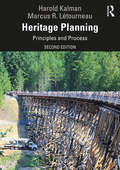- Table View
- List View
Dreams + Disillusions
by CJ Lim Luke AngersDreams + Disillusions explores the plethora of ideas and ideologies that have shaped and reshaped cities in profound ways. However, unlike a conventional title on the history of urbanism and architecture, its research fluctuates between the world of concrete reality and the multiple universes that exist in lucid prose, poetic visions, and the outrageous imaginations of history’s greatest and most (in)famous minds. In their thoughts are the foundations for political trends and new civilisations, alternative mappings and unlikely phenomena. The six chapters reveal dreams that were fundamental to the origin of great cities, underpinning the stories of the many lives within; and how, through circumstance or manipulation, fortunate coincidence or planned perfection, desires are sometimes left defeated and disillusioned.Myth and belief. Tradition and logic. Revolution and marginalisation. Ignorance and hubris. Sins and excess. Seasons and climate. Continuously interacting, shifting to enlighten and to enrage, these themes combine critical thinking with deep-rooted influences and new agencies that are a true sign of the times. The 18 illustrated speculations provide an abundance of curious imaginings, diverse provocations and satirical criticism. While there are distinctions between dreams and disillusions, could virtues be made of sins, or sensitivity be borne from hubris? Could progress advocate tradition, or should we re-attempt revolutions formerly experienced as disillusionments? Whether by bold gestures or by subtle attrition, cities are continually re-written crucibles for the human condition. In this book, we develop a better understanding of the discourse of cities tailored to the determining factors of climate, resources, and humanity’s idiosyncrasies to address a world in crisis.
China’s Railway Transformation: History, Culture Changes and Urban Development
by Junjie Xi Paco Mejias VillatoroThis book investigates China’s railway transformation through history, along with culture changes and urban development. The book begins by looking at the background of China and the history and growth of railway development in China through five key phases, followed by assessing the cultural changes in the railway carriage and exploring how these are linked to social equality and national provisions. The core of this book aims to analyse the Chinese urban transformation through the development of the high-speed rail (HSR) infrastructure in China. Eleven important new HSR stations in mainland China, plus the new Hong Kong West Kowloon Station, have been selected to contextually explore how HSR infrastructures have affected the development of the Chinese urban context. The selected case studies are the stations of Beijing South, Wuhan, Shanghai Hongqiao, Guangzhou South, Xi’an North, Nanjing South, Chengdu East, Tianjin West, Zhengzhou East, Hangzhou East and Hong Kong West Kowloon. All of these were built between 2008 and 2018. In these case studies, the location and the intentions and success of promoting urban development are analysed and assessed. Following this, the book further investigates the peculiarities of the new HSR stations in China in comparison with stations in Europe. An assessment framework is established to evaluate the Chinese case studies comparatively with significant cases in Europe, attending to the urban structure of the area, the architectural quality, the functional diversity and the quality of the public space generated in the surrounding area.
Pragmatic Spatial Planning: Practial Theory for Professionals
by Charles HochInstead of seeking theory to justify practical professional judgments this book describes how professionals can and should use theory to guide these judgments. Professional spatial planning in the US, and globally, continues to suffer from a weak conceptual grasp of its own practice. Practitioners routinely recognize the value and wisdom of practical judgment finely attuned to context, nuance and complexity; but later offer banal testimony and glib stories of ‘just so’ best-practice discrediting the ambiguity of their own experience. The chapters in this book provide a vocabulary tailored to the conventions of practical judgment, challenging students and practitioners to treat professional expertise as work in progress rather than ‘best’ practice. Instead of seeking theory to justify practical professional judgments, Hoch describes how professionals can and should use theory to guide these judgments. The pragmatist plan helps cope with complexity rather than control it, making it invaluable in the anyone’s pursuit of a planning career. This book will appeal to a wide cross section of students and scholars, especially those working in urban planning, public policy, and government.
Dreams + Disillusions
by CJ Lim Luke AngersDreams + Disillusions explores the plethora of ideas and ideologies that have shaped and reshaped cities in profound ways. However, unlike a conventional title on the history of urbanism and architecture, its research fluctuates between the world of concrete reality and the multiple universes that exist in lucid prose, poetic visions, and the outrageous imaginations of history’s greatest and most (in)famous minds. In their thoughts are the foundations for political trends and new civilisations, alternative mappings and unlikely phenomena. The six chapters reveal dreams that were fundamental to the origin of great cities, underpinning the stories of the many lives within; and how, through circumstance or manipulation, fortunate coincidence or planned perfection, desires are sometimes left defeated and disillusioned.Myth and belief. Tradition and logic. Revolution and marginalisation. Ignorance and hubris. Sins and excess. Seasons and climate. Continuously interacting, shifting to enlighten and to enrage, these themes combine critical thinking with deep-rooted influences and new agencies that are a true sign of the times. The 18 illustrated speculations provide an abundance of curious imaginings, diverse provocations and satirical criticism. While there are distinctions between dreams and disillusions, could virtues be made of sins, or sensitivity be borne from hubris? Could progress advocate tradition, or should we re-attempt revolutions formerly experienced as disillusionments? Whether by bold gestures or by subtle attrition, cities are continually re-written crucibles for the human condition. In this book, we develop a better understanding of the discourse of cities tailored to the determining factors of climate, resources, and humanity’s idiosyncrasies to address a world in crisis.
Rio de Janeiro: Urban Expansion and the Environment (Built Environment City Studies)
by José L. S. Gámez Zhongjie Lin Jeffrey S. NesbitUsing Rio de Janeiro as the case study city, this book highlights and examines issues surrounding the development of mega-cities in Latin America and beyond. Complex dynamics of urbanization such as mega-event-driven development, infrastructure investment, and informal urban expansion are intertwined with changing climatic conditions that demand new approaches to sustainable urbanism. The urban conditions facing 21st century cities such as Rio emphasize the need to revisit urban forms, reintegrate infrastructure, and re-evaluate practices. With contributions from 15 scholars from several countries exploring urbanism, urbanization, and climate change, this book provides insights into the contextual and environmental issues shaping Rio in the age of globalization. Each of the book’s three sections addresses an interdisciplinary range of topics impacting urbanism in Latin America, which will be accessible to researchers and professionals interested in urbanization, urban design, sustainability, planning, and architecture.
Rio de Janeiro: Urban Expansion and the Environment (Built Environment City Studies)
by José L. S. Gámez Zhongjie Lin Jeffrey S. NesbitUsing Rio de Janeiro as the case study city, this book highlights and examines issues surrounding the development of mega-cities in Latin America and beyond. Complex dynamics of urbanization such as mega-event-driven development, infrastructure investment, and informal urban expansion are intertwined with changing climatic conditions that demand new approaches to sustainable urbanism. The urban conditions facing 21st century cities such as Rio emphasize the need to revisit urban forms, reintegrate infrastructure, and re-evaluate practices. With contributions from 15 scholars from several countries exploring urbanism, urbanization, and climate change, this book provides insights into the contextual and environmental issues shaping Rio in the age of globalization. Each of the book’s three sections addresses an interdisciplinary range of topics impacting urbanism in Latin America, which will be accessible to researchers and professionals interested in urbanization, urban design, sustainability, planning, and architecture.
Marshall and Worthing's The Construction of Houses
by Duncan Marshall Derek Worthing Nigel Dann Roger HeathThe sixth edition of The Construction of Houses builds on the success of the previous five editions. The book provides a comprehensive introduction to the principles and processes of the construction of houses and their services. As such it is aimed at providing a broad understanding of domestic building construction for students as part of their academic studies and as a useful information source for practitioners. The existing chapters have all been updated and most of them expanded to take account of changes to dwelling house construction since the last edition and there are new chapters on ‘Modern Methods of Construction’ and ‘Regulatory controls and building standards’. Additionally, many new and/or updated photographs and diagrams have been added. As with the previous editions, the authors have concentrated on presenting current mainstream approaches to the construction of houses. The detailed, yet accessible, text that is supported by hundreds of coloured photographs and diagrams provides clear explanations of the many complex processes that go into the building of a house. A deeper insight into modern construction is also given by the book’s consideration of historical building techniques from the 18th century onwards in order to illustrate how and why we build houses in the way we do now.
Marshall and Worthing's The Construction of Houses
by Duncan Marshall Derek Worthing Nigel Dann Roger HeathThe sixth edition of The Construction of Houses builds on the success of the previous five editions. The book provides a comprehensive introduction to the principles and processes of the construction of houses and their services. As such it is aimed at providing a broad understanding of domestic building construction for students as part of their academic studies and as a useful information source for practitioners. The existing chapters have all been updated and most of them expanded to take account of changes to dwelling house construction since the last edition and there are new chapters on ‘Modern Methods of Construction’ and ‘Regulatory controls and building standards’. Additionally, many new and/or updated photographs and diagrams have been added. As with the previous editions, the authors have concentrated on presenting current mainstream approaches to the construction of houses. The detailed, yet accessible, text that is supported by hundreds of coloured photographs and diagrams provides clear explanations of the many complex processes that go into the building of a house. A deeper insight into modern construction is also given by the book’s consideration of historical building techniques from the 18th century onwards in order to illustrate how and why we build houses in the way we do now.
Professionalism in the Built Heritage Sector: Edited Contributions to the International Conference on Professionalism in the Built Heritage Sector, February 5-8, 2018, Arenberg Castle, Leuven, Belgium
by Koen Van Balen Aziliz VandesandeProfessionalism entails the conduct, aims and qualities that characterise a profession. The term is also used to describe education and training standards for the knowledge and skills necessary to perform a specific profession. In practice, professional standards of practice and ethics are agreed upon and maintained by recognised associations. In the past, professionalism has not occupied a central place in built heritage discussions, policy and research. Recent changes in terms of public attitudes and sustainability concerns have had a cumulative impact on the requirements for professionalism in the built heritage sector. The future success of the sector will depend on the availability of adequate professionals and an appropriately skilled workforce. In practice, the built heritage sector involves much more than interventions to conserve, preserve, rehabilitate or restore a heritage structure. Bringing a project to fruition begins with the formulation of a policy, proceeds to the design and execution of intervention strategies and ends with ongoing maintenance of heritage structures and related future programming. This process requires sufficient interactions between different professionals to obtain a common vision and hold that vision throughout a project. At the same time, the sustainability of the sector is also defined by effective governance, societal support and cultural rationales. Professionalism in the Built Heritage Sector contains reports on the lectures of the international conference organized by the Raymond Lemaire International Centre for Conservation (Leuven, Belgium, February 5th-8th, 2018). The contributions in this volume meet the increasing demand for shared information to support the transition towards a more sustainable conservation process. The volume consists of three main parts that deal with practice-led research or scientific research: "Profiles and capacities", "Education, training and quality labels", and "Obstacles and changes".
Museums and Design for Creative Lives
by Suzanne MacLeodMuseums and Design for Creative Lives questions what we sacrifice when we allow economic imperatives to shape public museums, whilst also considering the implications of these new museum realities. It also asks: how might we instead design for creative lives? Drawing together 28 case studies of museum design spanning 70 years, the book explores the spatial and social forms that comprise these successful examples, as well as the design methodologies through which they were produced. Re-activating a well-trodden history of progressive museum design and raising awareness of the involvement of the built forms in how we feel, think and act, MacLeod provides strategies and methods to actively counter the economisation of museums and a call to museum makers to work beyond the economic and advance this deeply human history of museum making. Museums and Design for Creative Lives will be of great interest to academics and students in museum studies, gallery studies, heritage studies, arts management, communication and architecture and design departments, as well as those interested in understanding more about design as a resource in museums. The book provides a valuable resource for museum leaders and practitioners.
Museums and Design for Creative Lives
by Suzanne MacLeodMuseums and Design for Creative Lives questions what we sacrifice when we allow economic imperatives to shape public museums, whilst also considering the implications of these new museum realities. It also asks: how might we instead design for creative lives? Drawing together 28 case studies of museum design spanning 70 years, the book explores the spatial and social forms that comprise these successful examples, as well as the design methodologies through which they were produced. Re-activating a well-trodden history of progressive museum design and raising awareness of the involvement of the built forms in how we feel, think and act, MacLeod provides strategies and methods to actively counter the economisation of museums and a call to museum makers to work beyond the economic and advance this deeply human history of museum making. Museums and Design for Creative Lives will be of great interest to academics and students in museum studies, gallery studies, heritage studies, arts management, communication and architecture and design departments, as well as those interested in understanding more about design as a resource in museums. The book provides a valuable resource for museum leaders and practitioners.
Solving Critical Design Problems: Theory and Practice
by Tania AllenSolving Critical Design Problems demonstrates both how design is increasingly used to solve large, complex, modern-day problems and, as a result, how the role of the designer continues to develop in response. With 13 case studies from various fields, including program and product design, Tania Allen shows how types of design thinking, such as systems thinking, metaphorical thinking, and empathy, can be used together with methods, such as brainstorming, design fiction, and prototyping. This book helps you find ways out of your design problems by giving you other ways to look at your ideas, so that your designs make sense in their setting. Solving Critical Design Problems encourages a design approach that challenges assumptions and allows designers to take on a more critical and creative role. With over 100 images, this book will appeal to students in design studios, industrial and product design, as well as landscape and urban design.
Solving Critical Design Problems: Theory and Practice
by Tania AllenSolving Critical Design Problems demonstrates both how design is increasingly used to solve large, complex, modern-day problems and, as a result, how the role of the designer continues to develop in response. With 13 case studies from various fields, including program and product design, Tania Allen shows how types of design thinking, such as systems thinking, metaphorical thinking, and empathy, can be used together with methods, such as brainstorming, design fiction, and prototyping. This book helps you find ways out of your design problems by giving you other ways to look at your ideas, so that your designs make sense in their setting. Solving Critical Design Problems encourages a design approach that challenges assumptions and allows designers to take on a more critical and creative role. With over 100 images, this book will appeal to students in design studios, industrial and product design, as well as landscape and urban design.
Urban Planning and Real Estate Development (Natural and Built Environment Series)
by John Ratcliffe Michael Stubbs Miles KeepingThis fourth edition of Urban Planning and Real Estate Development guides readers through the procedural and practical aspects of developing land from the point of view of both planner and developer. The twin processes of planning and property development are inextricably linked – it is not possible to carry out a development strategy without an understanding of the planning process, and, equally, planners need to know how real estate developers do their job. The planning system is explained, from the increasing emphasis on spatial planning at a national, local, and neighbourhood level down to the detailed perspective of the development management process and the specialist requirements of historic buildings and conservation areas. At the same time, the authors explain the entire development process from inception, through appraisal, valuation, and financing, to completion. Sustainability and corporate social responsibility and their impact on planning and development are covered in detail, and the future consequences of the COVID-19 pandemic are explored in new opening and closing chapters setting the text in a global context. Written by a team of authors with many years of academic, professional, and research experience, and illustrated throughout with practical case studies and follow-up resources, this book is an invaluable textbook for real estate and planning students and helps to meet the requirements of the RICS and RTPI Assessment of Professional Competence.
Urban Planning and Real Estate Development (Natural and Built Environment Series)
by John Ratcliffe Michael Stubbs Miles KeepingThis fourth edition of Urban Planning and Real Estate Development guides readers through the procedural and practical aspects of developing land from the point of view of both planner and developer. The twin processes of planning and property development are inextricably linked – it is not possible to carry out a development strategy without an understanding of the planning process, and, equally, planners need to know how real estate developers do their job. The planning system is explained, from the increasing emphasis on spatial planning at a national, local, and neighbourhood level down to the detailed perspective of the development management process and the specialist requirements of historic buildings and conservation areas. At the same time, the authors explain the entire development process from inception, through appraisal, valuation, and financing, to completion. Sustainability and corporate social responsibility and their impact on planning and development are covered in detail, and the future consequences of the COVID-19 pandemic are explored in new opening and closing chapters setting the text in a global context. Written by a team of authors with many years of academic, professional, and research experience, and illustrated throughout with practical case studies and follow-up resources, this book is an invaluable textbook for real estate and planning students and helps to meet the requirements of the RICS and RTPI Assessment of Professional Competence.
Embodied Time: Temporal Cues in Built Spaces
by Kevin NuteThe word time occurs more than seven times as often as space in written English, yet in the design of the indoor environments where we now spend most of our lives these priorities are typically reversed, with time often being little more than an afterthought. Embodied Time endeavors to correct that imbalance by demonstrating how built environments can be designed to evoke positive recollections of the past, interactions with the present, and anticipations of the future.
Embodied Time: Temporal Cues in Built Spaces
by Kevin NuteThe word time occurs more than seven times as often as space in written English, yet in the design of the indoor environments where we now spend most of our lives these priorities are typically reversed, with time often being little more than an afterthought. Embodied Time endeavors to correct that imbalance by demonstrating how built environments can be designed to evoke positive recollections of the past, interactions with the present, and anticipations of the future.
Neoliberal Housing Policy: An International Perspective (Explorations in Housing Studies)
by Keith JacobsNeoliberal Housing Policy considers some of the most significant housing issues facing the West today, including the increasing commodification of housing; the political economy surrounding homeownership; the role of public housing; the problem of homelessness; the ways that housing accentuates social and economic inequality; and how suburban housing has transformed city life. The empirical focus of the book draws mainly from the US, UK and Australia, with examples to illustrate some of the most important features and trajectories of late capitalism, including the commodification of welfare provision and financialisation, while the examples from other nations serve to highlight the influence of housing policy on more regional- and place-specific processes. The book shows that developments in housing provision are being shaped by global financial markets and the circuits of capital that transcend the borders of nation states. Whilst considerable differences within nation states exist, many government interventions to improve housing often fall short. Adopting a structuralist approach, the book provides a critical account of the way housing policy accentuates social and economic inequalities and identifies some of the significant convergences in policy across nations states, ultimately offering an explanation as to why so many ‘inequalities’ endure. It will be useful for anyone in professional housing management/social housing programmes as well as planning, sociology (social policy), human geography, urban studies and housing studies programmes.
Neoliberal Housing Policy: An International Perspective (Explorations in Housing Studies)
by Keith JacobsNeoliberal Housing Policy considers some of the most significant housing issues facing the West today, including the increasing commodification of housing; the political economy surrounding homeownership; the role of public housing; the problem of homelessness; the ways that housing accentuates social and economic inequality; and how suburban housing has transformed city life. The empirical focus of the book draws mainly from the US, UK and Australia, with examples to illustrate some of the most important features and trajectories of late capitalism, including the commodification of welfare provision and financialisation, while the examples from other nations serve to highlight the influence of housing policy on more regional- and place-specific processes. The book shows that developments in housing provision are being shaped by global financial markets and the circuits of capital that transcend the borders of nation states. Whilst considerable differences within nation states exist, many government interventions to improve housing often fall short. Adopting a structuralist approach, the book provides a critical account of the way housing policy accentuates social and economic inequalities and identifies some of the significant convergences in policy across nations states, ultimately offering an explanation as to why so many ‘inequalities’ endure. It will be useful for anyone in professional housing management/social housing programmes as well as planning, sociology (social policy), human geography, urban studies and housing studies programmes.
Writing for Planners: A Handbook for Students and Professionals in Writing, Editing, and Document Production
by Claudia KousoulasWriting is never easy, but this book can make it easier. With attentiveness and experience, Claudia Kousoulas gives readers applied writing, editing, and production approaches that provide a clear path to completing a document and tools that ensure it is engaging and professional. The book follows a project’s path from initial assignment and conception, through sorting out what’s significant, shaping it into a message, and guiding readers to an action. It addresses the different types of documents planners have to create, the different media they use, and the different audiences they address. Its strategies will help writers start a project and see it through to a clear and coherent piece of work that serves its purpose. This book will help planners meet the challenges of creating work that is accurate, creative, and useful. Students will find it helpful in providing professional standards and quick reference information, and professionals will carry it through their careers as a reference, and as a way to establish workplace standards and improve their own work.
Writing for Planners: A Handbook for Students and Professionals in Writing, Editing, and Document Production
by Claudia KousoulasWriting is never easy, but this book can make it easier. With attentiveness and experience, Claudia Kousoulas gives readers applied writing, editing, and production approaches that provide a clear path to completing a document and tools that ensure it is engaging and professional. The book follows a project’s path from initial assignment and conception, through sorting out what’s significant, shaping it into a message, and guiding readers to an action. It addresses the different types of documents planners have to create, the different media they use, and the different audiences they address. Its strategies will help writers start a project and see it through to a clear and coherent piece of work that serves its purpose. This book will help planners meet the challenges of creating work that is accurate, creative, and useful. Students will find it helpful in providing professional standards and quick reference information, and professionals will carry it through their careers as a reference, and as a way to establish workplace standards and improve their own work.
The Architecture of Ruins: Designs on the Past, Present and Future
by Jonathan HillThe Architecture of Ruins: Designs on the Past, Present and Future identifies an alternative and significant history of architecture from the sixteenth century to the twenty-first century, in which a building is designed, occupied and imagined as a ruin. This design practice conceives a monument and a ruin as creative, interdependent and simultaneous themes within a single building dialectic, addressing temporal and environmental questions in poetic, psychological and practical terms, and stimulating questions of personal and national identity, nature and culture, weather and climate, permanence and impermanence and life and death. Conceiving a building as a dialogue between a monument and a ruin intensifies the already blurred relations between the unfinished and the ruined and envisages the past, the present and the future in a single architecture. Structured around a collection of biographies, this book conceives a monument and a ruin as metaphors for a life and means to negotiate between a self and a society. Emphasising the interconnections between designers and the particular ways in which later architects learned from earlier ones, the chapters investigate an evolving, interdisciplinary design practice to show the relevance of historical understanding to design. Like a history, a design is a reinterpretation of the past that is meaningful to the present. Equally, a design is equivalent to a fiction, convincing users to suspend disbelief. We expect a history or a novel to be written in words, but they can also be delineated in drawing, cast in concrete or seeded in soil. The architect is a ‘physical novelist’ as well as a ‘physical historian’. Like building sites, ruins are full of potential. In revealing not only what is lost, but also what is incomplete, a ruin suggests the future as well as the past. As a stimulus to the imagination, a ruin’s incomplete and broken forms expand architecture’s allegorical and metaphorical capacity, indicating that a building can remain unfinished, literally and in the imagination, focusing attention on the creativity of users as well as architects. Emphasising the symbiotic relations between nature and culture, a building designed, occupied and imagined as a ruin acknowledges the coproduction of multiple authors, whether human, non-human or atmospheric, and is an appropriate model for architecture in an era of increasing climate change.
The Architecture of Ruins: Designs on the Past, Present and Future
by Jonathan HillThe Architecture of Ruins: Designs on the Past, Present and Future identifies an alternative and significant history of architecture from the sixteenth century to the twenty-first century, in which a building is designed, occupied and imagined as a ruin. This design practice conceives a monument and a ruin as creative, interdependent and simultaneous themes within a single building dialectic, addressing temporal and environmental questions in poetic, psychological and practical terms, and stimulating questions of personal and national identity, nature and culture, weather and climate, permanence and impermanence and life and death. Conceiving a building as a dialogue between a monument and a ruin intensifies the already blurred relations between the unfinished and the ruined and envisages the past, the present and the future in a single architecture. Structured around a collection of biographies, this book conceives a monument and a ruin as metaphors for a life and means to negotiate between a self and a society. Emphasising the interconnections between designers and the particular ways in which later architects learned from earlier ones, the chapters investigate an evolving, interdisciplinary design practice to show the relevance of historical understanding to design. Like a history, a design is a reinterpretation of the past that is meaningful to the present. Equally, a design is equivalent to a fiction, convincing users to suspend disbelief. We expect a history or a novel to be written in words, but they can also be delineated in drawing, cast in concrete or seeded in soil. The architect is a ‘physical novelist’ as well as a ‘physical historian’. Like building sites, ruins are full of potential. In revealing not only what is lost, but also what is incomplete, a ruin suggests the future as well as the past. As a stimulus to the imagination, a ruin’s incomplete and broken forms expand architecture’s allegorical and metaphorical capacity, indicating that a building can remain unfinished, literally and in the imagination, focusing attention on the creativity of users as well as architects. Emphasising the symbiotic relations between nature and culture, a building designed, occupied and imagined as a ruin acknowledges the coproduction of multiple authors, whether human, non-human or atmospheric, and is an appropriate model for architecture in an era of increasing climate change.
Heritage Planning: Principles and Process
by Harold Kalman Marcus R LétourneauThis new and substantially revised edition of Heritage Planning: Principles and Process offers an extensive overview of the burgeoning fields of heritage planning and conservation. Positioning professional practice within its broader applied and theoretical contexts, the authors provide a firm foundation for understanding the principles, history, evolution, debates, and tools that inform heritage planning, while also demonstrating how to effectively enact these processes. Few published works focus on the practice of heritage planning. The first edition of this book was developed to fill this gap, and this second edition builds upon it. The book has been expanded in scope to incorporate new research and approaches, as well as a wide range of international case studies. New themes reflect the emerging recognition that sustainability, climate resilience, human rights, social justice, and reconciliation are fundamental to the future of planning. Heritage Planning is indispensable reading, not only for professionals who transform the built environment, but for anyone who wants to understand the ideas and practices of heritage planning and conservation. For the benefit of student readers, twelve chapters—designed to accommodate the academic semester—are augmented with concise summaries, key terms and definitions, questions, and learning objectives.
Heritage Planning: Principles and Process
by Harold Kalman Marcus R LétourneauThis new and substantially revised edition of Heritage Planning: Principles and Process offers an extensive overview of the burgeoning fields of heritage planning and conservation. Positioning professional practice within its broader applied and theoretical contexts, the authors provide a firm foundation for understanding the principles, history, evolution, debates, and tools that inform heritage planning, while also demonstrating how to effectively enact these processes. Few published works focus on the practice of heritage planning. The first edition of this book was developed to fill this gap, and this second edition builds upon it. The book has been expanded in scope to incorporate new research and approaches, as well as a wide range of international case studies. New themes reflect the emerging recognition that sustainability, climate resilience, human rights, social justice, and reconciliation are fundamental to the future of planning. Heritage Planning is indispensable reading, not only for professionals who transform the built environment, but for anyone who wants to understand the ideas and practices of heritage planning and conservation. For the benefit of student readers, twelve chapters—designed to accommodate the academic semester—are augmented with concise summaries, key terms and definitions, questions, and learning objectives.
